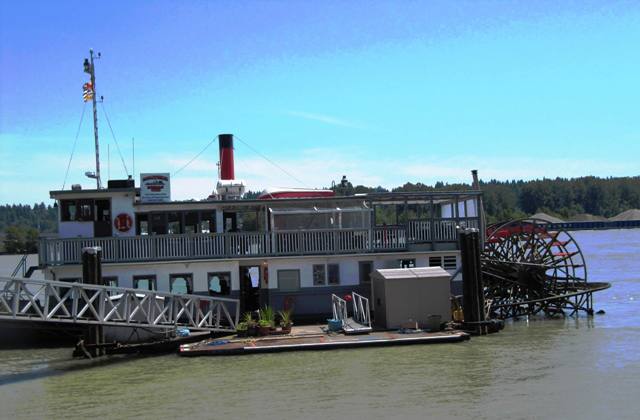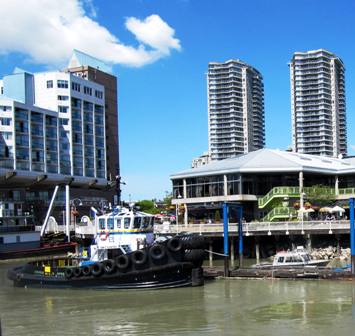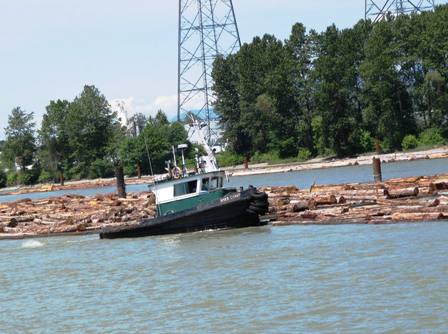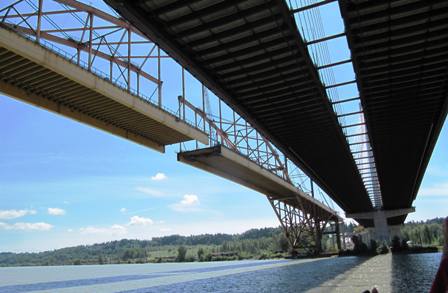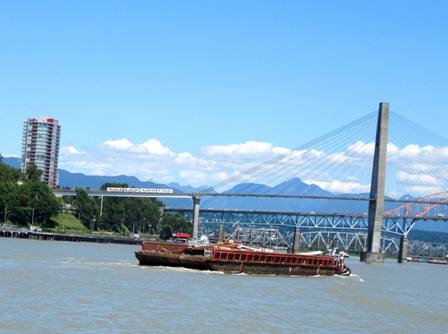JOURNEY THROUGH TIME ON THE FRASER RIVER
by Margaret Deefholts
It is one of those perfect days – brilliant sunshine, powder blue skies and a soft breeze that carries the scent of summer on its breath. Along with a group of friends, I board The Native , a pretty paddle-wheeler moored on the Fraser River alongside the New Westminster boardwalk.
Today is the first day of summer, and the scene along the waterfront is lively: a whiskered old man with bright blue eyes plays Home on the Range on his mouth harmonica, the hat at his feet gathering coins from passers by. A teenager on skates, whizzes past me; a woman in a business suit, cell phone to her ear, strides along briskly; a chubby toddler poses for his adoring parents who coo to him in Chinese.
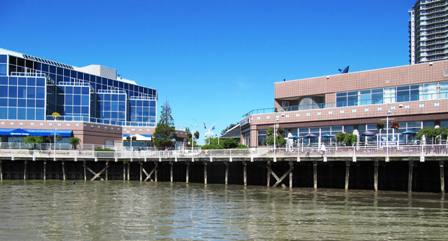
Westminster Quay
As we settle down on the boat, a horn signals our departure, the captain's voice booms over the PA system as he welcomes us aboard, and the paddles begin to churn. Our hostesses bustle around taking orders for the bar and a buzz of animated conversation floats across the deck as we cast off on our two-and-a-half hour cruise upstream.
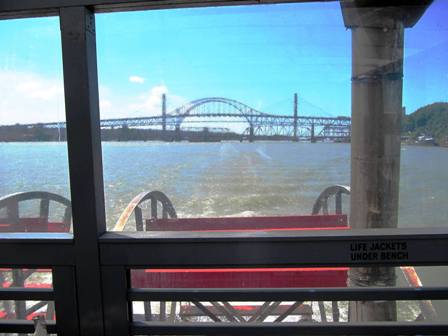
At first glance, the Fraser river is muscular—an industrial waterway shouldering log booms, tugs and barges to the lumber mills lining its route through the Fraser Valley. But the Fraser is much more than that. It is a river with glinting shifts of mood and colour. It needles its way through forests and mountain canyons and then flows leisurely through the Valley's rich farm land. It is filled with the whispers of old Indian legends, and robust tales of the Province's gold-rush era.
 |
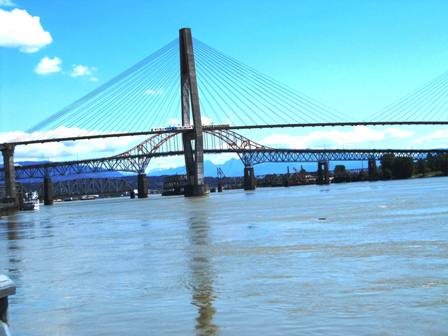 |
|---|
The Fraser is also the skein which weaves through the lives of the 2.4 million people who live and work along its 1,368 kilometre route from the rugged mountains deep in the heart of British Columbia, to the Delta where it empties into the Gulf of Georgia. It nourishes a unique ecology of plant, fish and bird life, and has been a partner in the Province's history and development over the past two centuries.
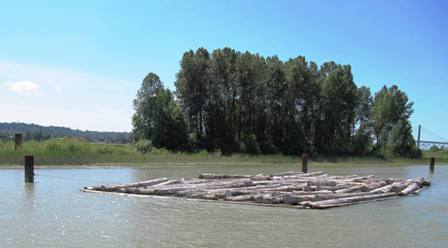 |
|---|
As the scenery unfolds, so does the history of the Fraser River ... the old gold rush days, (when there were more paddle-wheelers along the Fraser than on the Mississippi) are gone, but the Fraser remains at the heart of B.C's economy, the lumber industry in particular. Logs braided into raft-like booms, lie against the shoreline, and cheeky little boom-boats dance around them, nudging errant sticks into place. Self-important tugs draw barges piled high with wood chips or sawdust-perhaps not as shiny as nuggets or gold-dust, but in today's marketplace, almost as valuable.
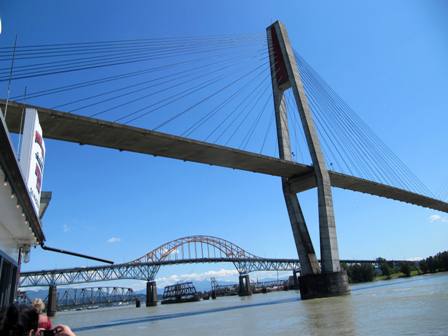
We move smoothly under the first of several bridges that span the river – Surrey's Skybridge which from this angle looks like a giant harp, with its strings aslant against the sky. Just beyond this is the venerable old Pattullo bridge opened in 1937. It's orange metal Meccano-set-like archway is a familiar sight to commuters who drive its lanes every day as they stream into New Westminster from Surrey. Also, along our journey this morning, is the century-old Fraser River Swing Bridge that still carries freight and passenger trains. We edge through it's narrow port-side corridor; cameras aloft, passengers capture a shot of the splintered-wood damage done to one end of the “wing” by a vessel whose pilot misjudged the strength of the tide and the width of his boat.
Breaking into open water past the bridge, t he river is a pastiche of impressions. An osprey sits on a piling, its feathers ruffled by the breeze. A speedboat buzzes past us like an angry hornet. A goods train worms its way along the distant Surrey shoreline. Hugging the bank, a log salvage barge, its crane outstretched like some ungainly pterodactyl's beak, creaks as it retrieves an errant deadhead. Wild grass, alder and cottonwood trees doze gently on small islands in mid-channel and up ahead, the coastal mountains smudge the sky in blue and grey silhouettes. Powder puff clouds drift lazily overhead.
The gates to what was once the B.C. Penitentiary comes into view to our left. No longer a grim fortress, this has been transformed into a romantic restaurant dubbed “Dublin Castle” complete with fairy-tale like columns and ramparts. However, not everything is as idyllic.
Coquitlam's Mary Hill lies further inland, and even at this distance, it remains an eye-sore of overdevelopment—huddled buildings scarring the slopes. The historic Fraser Mills lumberyard and buildings that existed along the river's edge are folded away into the past now, and in its place, I'm told that a residential subdivision may take shape in the next few years.
Past TimberWest's log sort area, where a boom boat is busily nosing logs into place, the new Port Mann bridge looms against the sky. We glide under its mammoth concrete arches, and just beyond its stanchions, the old bridge is a crumbling mess of concrete and steel rods. Now in the process of demolition, it will soon be the stuff of history, of faded photograph albums and anecdotal tales told by Fraser Valley old timers.
At Mission, we are joined by our river pilot. This part of the Fraser is tricky to navigage, but our expert has the uncanny ability to read the ripped surface of the river and can pick his way, delicate as a dancer, through the sand and gravel bars that wind spaghetti like throughout this section. It's an easy ride this time, however, as the sandbanks are submerged far below the surface of the swollen waters.
Gravel bars are spawning grounds for salmon, and during the salmon run, river traffic is halted along this stretch of the Fraser. This is also the home of the River's oldest and grandest piscine resident. Weighing between 500 and 750 pounds, the mighty sturgeon's evolutionary history dates back 150 million years to the Cretaceous period.
At the mouth of the Harrison River the water turns emerald green, and as we cruise onto the lake, our host tells us that the hot springs were discovered accidentally by miners whose boat capsized nearby. They were astonished and, no doubt delighted, to find that instead of freezing to death, they were in the middle of a gush of warm water.
After a sumptuous lunch at the Harrison Hot Springs Hotel we make our way back to New Westminster by coach. As we round a curve along the road, I catch a bird's eye view of the Fraser. Laden with its riches of silt. Powerful. Confident. An inscrutable witness to the passage of time. Forever British Columbia's heritage and its future.
